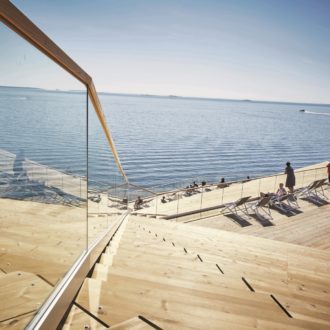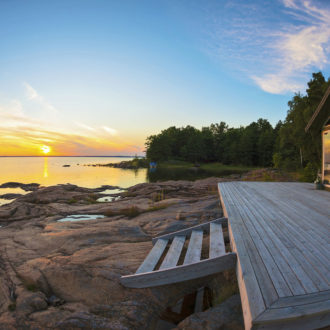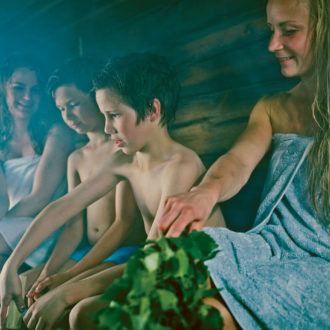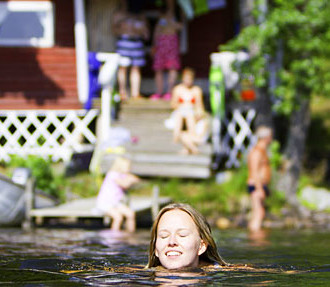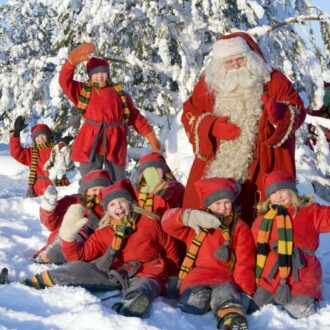A sauna is more than just a place to sweat, bathe and relax. Finnish people may read in the sauna, hang clothes to dry in the sauna, wash a newborn baby in the sauna, do yoga in the sauna and even cook in the sauna.
The most common way to prepare food in a sauna is to wrap some sausages in tinfoil and roast them on the sauna stove. Add some garlic or cheese and voilà, dinner cooks itself while you are enjoying the löyly (literally “steam,” but in a wider sense the word stands for the whole feeling and atmosphere of the sauna).
Turning necessity into virtue

Author Katariina Vuori (right) originally started cooking meals in the sauna so she could stay near the lakeshore and supervise the kids while they swam.Photo: Vesa Ranta
Sauna cuisine isn’t a new thing – Finnish people have utilised the sauna stove, with its heated rocks and water basin, in various household chores such as laundry and cooking for as far back as anyone can remember, and then some. Archival information about sauna cooking is sparse, but the Finns are known to have cooked Christmas ham and even school meals in saunas back in the 1940s.
At that time, most Finns lived in the countryside, a great many still without electricity or running water. The idea was to make the best possible use of the warmth and warm water produced by heating up the sauna.
As a young girl, Finnish author Katariina Vuori watched her grandmother cook fish, freshly caught from the lake, in the furnace portion of a sauna stove. The idea of an actual book called Saunakeittokirja (Sauna Cookbook, Tammi, 2014) came to her far from home, in the middle of the Indian Ocean on a sailboat in the late 1990s.
However, it took until 2011, when Vuori was at her summer cottage with her kids, for her to start broadening her sauna cooking perspectives from sausages and smoked bream to cooking and baking nearly every meal in sauna. The reason was practical: her kids loved swimming in the lake and Vuori had to keep an eye on them. So she started cooking in the lakeshore sauna in order to look after her children at the same time.
Relaxed attitude
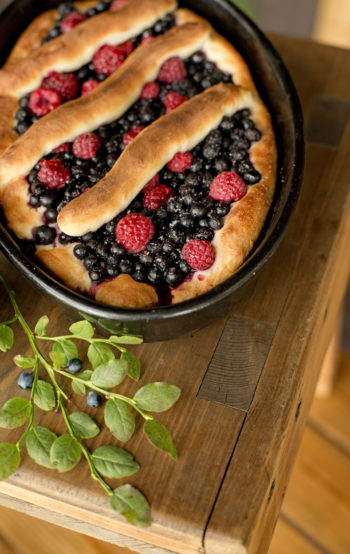
A summer favourite: Berries ripen in the Finnish forests and taste great in a sauna-baked pie.Photo: Vesa Ranta
“You can cook anything in a sauna,” Vuori says, who co-authored the book with Janne Pekkala. “But you have to have a more relaxed attitude than in a normal kitchen. Cooking time varies depending on the sauna, so you have to make sure you keep a constant eye on the food.”
The stones are at their hottest right after wood is added to the fire, so that is a good time for frying food. Also note the size of the stove: the smaller the stove, the faster it heats up, and the larger the stove, the more moderate and smooth the heat will be.
“You’ll get to know your stove quickly,” says Vuori. “If you want to start easy, begin with casseroles.”
There are several things to consider before beginning. The main thing is that the furnace portion works as an oven and the rocks act like a stove. With an electrically heated sauna you have to be extra careful not to spill anything on the rocks. The sauna stove should be flat and large enough for cooking.
Vuori prefers a wood-heated sauna. A wood-heated water basin works great for cooking vacuum-packed food. And don’t forget the smoke sauna, a Finnish speciality that leaves sauna-goers’ skin with a unique smoky scent; food cooked in a smoke sauna picks up a smoky flavour. Whatever sauna you choose, make sure the stove is hot enough.
Nineteen different saunas
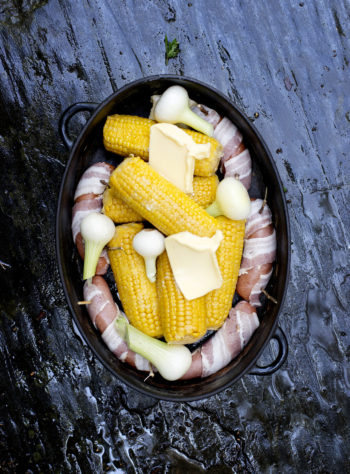
Ready to roast: Fresh corn on the cob, sausages wrapped in bacon, and onions will fill the sauna with savoury aromas.Photo: Vesa Ranta
As for cooking dishes, make sure that they are flame resistant – ovenproof is not enough. Cast iron is always a sound choice. Use long-sleeved oven mitts when the furnace is open and you’re inserting or removing food.
If all that sounds like a bit too much, you can always just cook an omelette in the scoop you use to throw water on the stones, if it’s made of metal. Just line it with tinfoil to keep the food from absorbing metallic flavours from the scoop.
Vuori travelled 6,000 kilometres while researching the sauna cookbook. In addition to presenting recipes, the volume offers detailed looks at 19 different saunas in locations all over Finland.
“The most memorable saunas we cooked in were that of Finland’s former president, Urho Kekkonen, in Karigasniemi [in the Finnish far north], and an underground sauna made of granite blocks on [the southwestern Finnish island of] Kemiö,” says Vuori.
By Jonna Pulkkinen, July 2017
